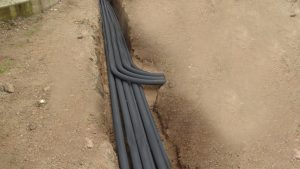How are 2023 NEC rules for PVC conduit use in concrete and high-stress applications?
Overview
Rigid Poly-Vinyl Chloride (PVC) is widely recognized for its reliability and durability in electrical wiring conduits. However, despite its resilience, certain conditions can compromise its performance. Factors such as temperature variations and physical pressure may lead to a loss of rigidity and inertness in PVC conduits. To address this, NEC Section 352.10 outlines the permitted uses of PVC conduits, ensuring they are not subjected to excessive stress. In the 2023 edition, additional allowances have been made for PVC conduits, including scenarios where they are embedded in concrete and the use of Schedule 80 PVC conduits in high-stress environments due to their thicker construction. These updates aim to extend the benefits of PVC conduits to a wider range of applications.
compromise its performance. Factors such as temperature variations and physical pressure may lead to a loss of rigidity and inertness in PVC conduits. To address this, NEC Section 352.10 outlines the permitted uses of PVC conduits, ensuring they are not subjected to excessive stress. In the 2023 edition, additional allowances have been made for PVC conduits, including scenarios where they are embedded in concrete and the use of Schedule 80 PVC conduits in high-stress environments due to their thicker construction. These updates aim to extend the benefits of PVC conduits to a wider range of applications.
Applying the 2023 Code
PVC is a widely favored material for both indoor and outdoor applications due to its resistance to corrosion, chemicals, and physical impacts, making it a dependable choice for electrical, telecommunication, and cable installations. However, caution is necessary when using PVC in extreme temperature conditions as it may become brittle in cold temperatures or soft in high heat, rendering it more prone to damage. Additionally, inadequate thickness of PVC conduits can compromise their durability when exposed to physical pressure and hazards. To address these concerns, NEC Section 352.10 underwent revisions in the 2023 edition to allow for the use of PVC conduits in concrete burial applications. Furthermore, the use of Schedule 80 PVC conduits was permitted for situations where the piping would endure physical stress, owing to their increased thickness. These updates expand the range of applications where PVC can be safely utilized.
What’s New for the 2023 NEC?
2020 NEC
In the 2020 NEC Section 352.10 had nine subsections to cover the permitted uses / locations for rigid PVC conduits.
2023 NEC
In the 2023 NEC Section 352.10, two additional subsections (B) and (K) were introduced, permitting the use of PVC conduits in scenarios requiring enclosures in concrete and where susceptibility to physical damage is a concern. These additional subsections read as follows (without exceptions and informational notes):
(B) Encased in Concrete
PVC conduit shall be permitted to be encased in concrete.
(K) Physical Damage
Where subject to physical damage, Schedule 80 PVC conduit, Schedule 80 PVC elbows, and listed fittings for PVC conduit shall be used.
